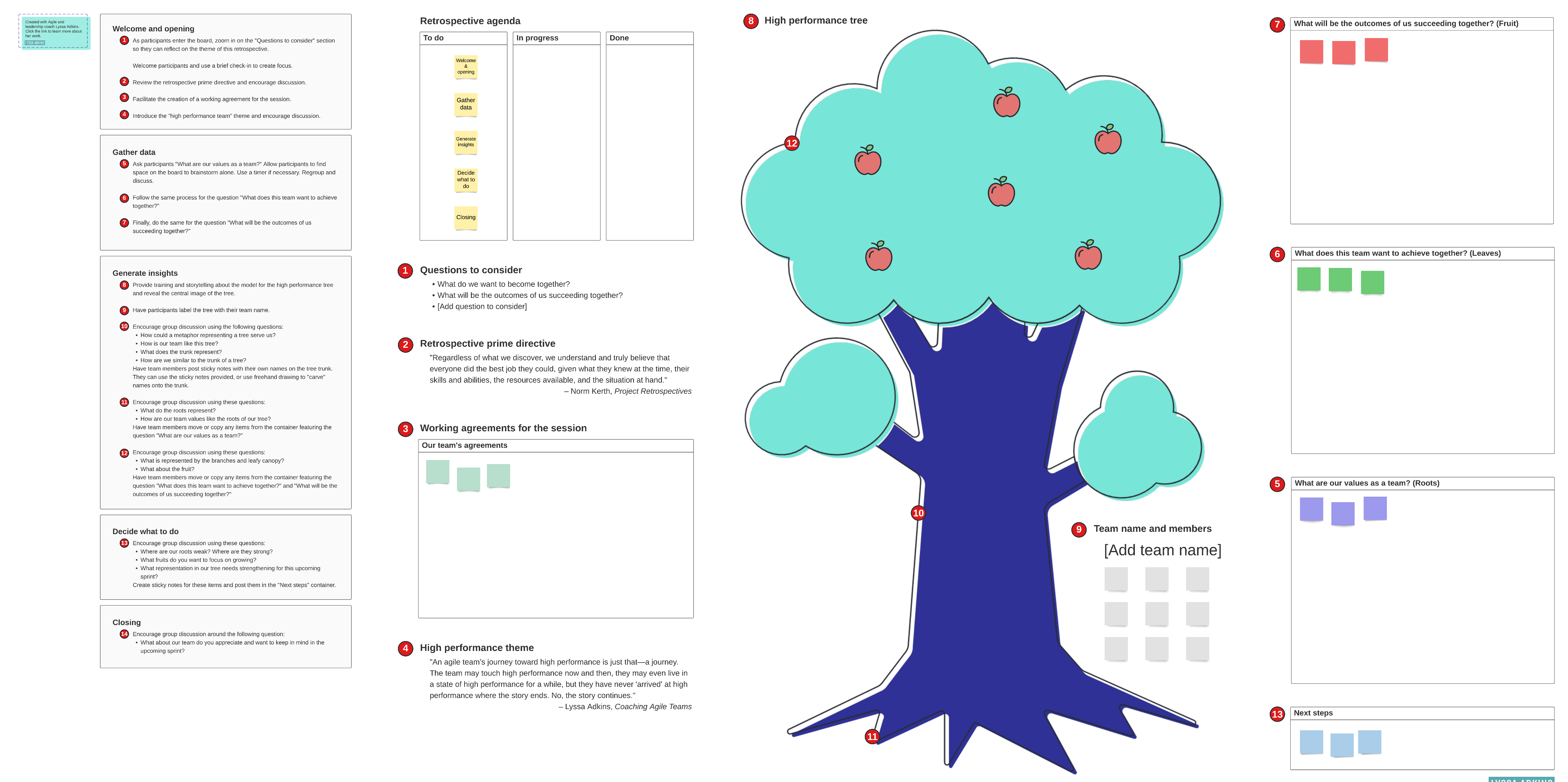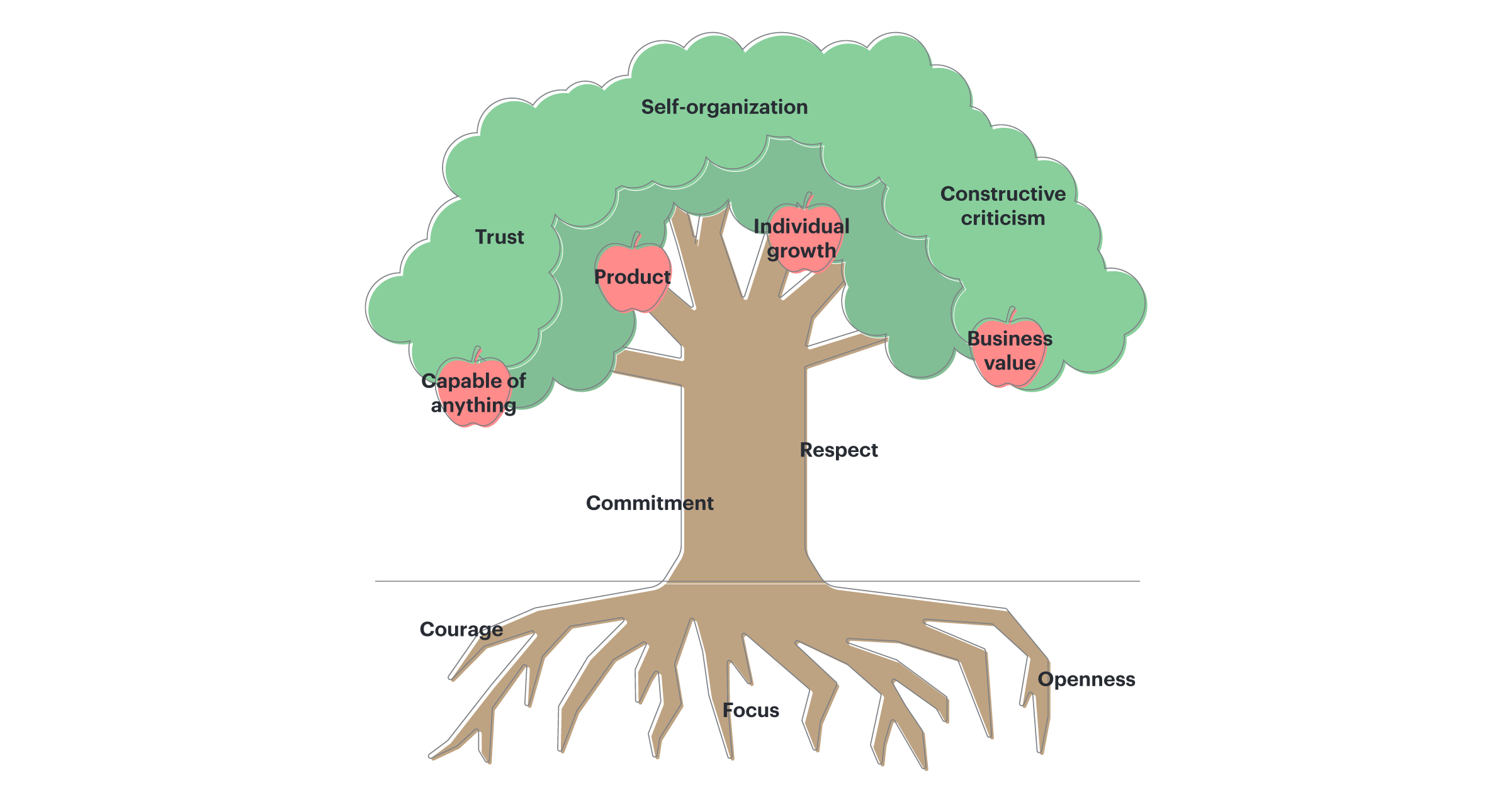
Why high performance is a journey and not a destination
Reading time: about 7 min
In Lyssa Adkins's on-demand webinar, and in her book "Coaching Agile Teams," she shared a metaphor of a "high performance tree" to help teams reflect on the work they've done recently and figure out how to do better, more fulfilling work in the future.
The high performance tree template illustrates how effective teams don't just focus on the fruit or the products and end results—they focus on the roots and leaves, or the people and processes, too.
High performance is not an end goal, something to arrive at, evaluate, and replicate. It's a journey that involves making choices, taking risks, and reflecting on experiences in the name of working on something that everyone can be proud of. Using this metaphor, teams can view high performance as a journey rather than a destination—and work with more flexibility and agility as a result.
With this high performance mindset, your teams can let go of rigidity, embrace the potential of every project, and uncover opportunities to improve and learn.

Embracing a high-performance journey vs. destination
Speaking of metaphors, we can also draw some comparisons between high performance at work and athletic performance. Whether you're a weekend warrior or an Olympic hopeful, there's no "finish line" when it comes to fitness. You don't get strong and fast and stay that way—you have to keep training to maintain that level of performance or push harder to improve upon it.
To keep their athletes on track, coaches and sports psychologists train their athletes to visualize the race or feat ahead of them. A marathon runner, for example, will imagine and run through every possible circumstance of a race or event with a goal or ideal outcome in mind.
What happens when the race doesn't go quite according to plan, and how will you adjust your race plan? How will you respond when your body starts to tire? How can you see yourself winning despite the challenges you face throughout the race?
Similarly, teams can use visuals like the high performance tree and Agile methodologies to continuously adapt and improve to reach their goals.
The high performance tree pushes teams to start at the root of great teamwork—i.e., the values that drive them. For Agile teams, these values are things like
- Commitment
-
Focus
-
Openness
-
Respect
-
Courage
-
Communication
-
Simplicity
-
Feedback
These values are the roots or building blocks that will help teams grow into high performers. By focusing on shared values, your team can grow together, developing characteristics (the leaves of the trees) that can bring forth valuable fruit. For instance, your team may begin to be
-
Empowered to make decisions
-
Committed to team success
-
Consensus-driven
-
Accountable for their decisions and commitments
As your team develops the characteristics of high performance, you will soon start to see that reflected in the fruits of their work. The more results your team sees, the more that feeds back into the root values—creating a sustainable cycle of high performance.
By switching from verbal to visual channels like the high performance tree, teams can better understand the full scope of a project and all of its dependencies. This 360-degree vision allows the brain to think more creatively, respond with more agility, and think of more innovative solutions to challenging problems.

Tips on maintaining a state of high performance
Maintaining a level of high performance requires a constant commitment to adaptation. Usain Bolt only maintains his speed by continually working on his technique, optimizing his training, recovering from his training, and adapting his training to reach new heights in performance.
These principles apply to the way work gets done, too. Even the most buttoned-up project managers and expert Agile teams know that product development rarely goes entirely according to plan, and even the best sprints can leave room for improvements in process, mindset, and technology.
Focusing on high performance rather than a final destination can help your team find motivation and satisfaction in the journey to make incredible, worthwhile products. Here are a few tips to help your teams stay agile, recover from setbacks and changes, and stay motivated during the product development process.
Focus on morale
As Lyssa states in her book, Agile frameworks are designed to be simple and easy to set in motion. But without proper management, they can also make teams feel like they're racing from one sprint to another, always making progress but stuck running laps.
Notice what motivates your team, and notice how these motivations vary across each member of your team. Some may find a lot of intrinsic satisfaction in a job well done and a sprint complete. Some are self-motivated by personal growth and learning. Others may need more extrinsic or external motivation.
Once you understand your team's motivations, you can establish processes, incentives, and even recurring or one-off events to look forward to. Now and then, take the reins off your team and give them space for more divergent ways of thinking.
Hackathons are a popular way to think beyond current workflows and focus on innovative solutions to new or existing problems—they're also not reserved for developers or product teams. They can be excellent opportunities for cross-functional collaboration, which may spur new ways of thinking, too.
High performance may mean different things to different team members, but establishing a shared vision on what success means will help you collectively get through hard times and challenging sprints together.
Establish a long-term vision
Just like trained athletes, high-performance teams visualize their progress and how they'll deal with situations that arise in their journey toward a shared objective. It's important to establish a long-term vision of what your team is working to achieve, but it's equally important for Agile teams to be open to the final product looking different from what you might expect.
Focus on milestones and checkpoints to give you proof points of your progress along the way. Strategies and benchmarks like a Definition of Done (DoD) can help your team stay flexible, productive, and focused.
Deliver consistent feedback
High-performance also relies on regular checkpoints, consistent feedback, and ongoing evaluation of your team's progress. The performance tree template can help you deliver feedback visually as a project manager. Teams can effectively:
- Evaluate the holistic experience of a recent experience or project, from the roots to the leaves to the fruit;
- Identify what went right and what could have been done better;
- Help team members visualize how they can adapt to deliver an even better outcome.
Remove roadblocks
Sometimes, roots get gnarled. A late frost can kill budding leaves. Not every piece of fruit is perfect, and projects rarely go exactly according to plan. However, the most fruitful trees—and teams—adapt to these threats. And the most successful project leaders coach teams to expect roadblocks along the way while using visuals like the performance tree template to help their teams better anticipate challenges and stay agile.
How to create the expectation of high performance as a leader
You can state your expectations and hope for your team's motivation and behavior to meet that expectation—or you can establish a culture where high-performance expectations are simply a part of the way teams interact and work gets done.
The Lucidspark high-performance tree template involves the entire process of high-performance team growth, from establishing roots and values to cultivating productive behaviors and collaboration to bearing the fruit or success of the project. The high performance tree template and metaphor helps teams visualize their contributions to the whole and the process of growth, effort, and creating shared ideals.
As a leader, the high performance tree template can help you continuously communicate high-performance expectations and navigate what goes into that process.

Build a stronger team and achieve your high performance goals. Watch Lyssa Adkin's webinar
Watch nowAbout Lucidchart
Lucidchart, a cloud-based intelligent diagramming application, is a core component of Lucid Software's Visual Collaboration Suite. This intuitive, cloud-based solution empowers teams to collaborate in real-time to build flowcharts, mockups, UML diagrams, customer journey maps, and more. Lucidchart propels teams forward to build the future faster. Lucid is proud to serve top businesses around the world, including customers such as Google, GE, and NBC Universal, and 99% of the Fortune 500. Lucid partners with industry leaders, including Google, Atlassian, and Microsoft. Since its founding, Lucid has received numerous awards for its products, business, and workplace culture. For more information, visit lucidchart.com.
Related articles
Using Lucidchart for Agile methodology
Want your company to innovate faster? We’ve mapped out how you can use Lucidchart to roll out the Agile methodology in three main categories across your organization: people, process, and systems.
How to effectively gather team feedback for improving processes
In this article, we’ll discuss how to streamline feedback loops, minimize rounds of revision and duplicative work, and continue to simplify and improve processes.
Why Giving Feedback Matters to Your Employees
When you learn how to give positive feedback, you can have a greater influence on your organization and develop more meaningful work relationships. Explore 3 ways you can become more effective at giving and receiving feedback.
